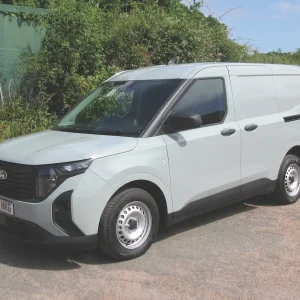Nor has it been given an easy time of it. Laden with bricks, bags of gravel, pots of paint and step-ladders, it’s tackled regular trips from Peterborough to Ross-on-Wye and back again without complaint.
It has carted large pieces of furniture about too – including an ancient sofa with a mind of its own that looked as though it was once home to a family of mice – as well as mountains of packaging and bags of garden rubbish. Given that it’s the short-wheelbase standard-roof version, which makes it the smallest model in the solidly-built Crafter van range, it’s remarkable how much the 7.5cu m load area will swallow.
I tended to load through the nearside sliding door whenever possible, to make use of the handily-positioned grab-handle and step. The rear door aperture boasts neither, which makes entering through it a bit of a climb. 
Maybe it’s because we’ve become so familiar with it but we’d swear that the rear-wheel drive Crafter’s always predictable handling has got better as the weeks have gone by. The compliant ride has continued to cope with Britain’s steadily-collapsing road surfaces with aplomb and noise levels remain well-suppressed.
Fuel economy has steadily improved and is now averaging between 32-33mpg.
Drawbacks?
With the 109hp version of the 2.5-litre Blue TDI engine under the bonnet, this version’s never going to win the traffic lights grand prix, especially when heavily laden. Overtaking manoeuvres have to be planned carefully and executed with care.
If you do misjudge things then at least you can guarantee that the Crafter’s daytime running lights will ensure that whoever is coming the other way will spot you bearing down on them. Otherwise we remain to be convinced that they’re genuinely necessary.
While the six-speed manual gearbox co-operates with the driver the majority of the time, it is a little noisy; noisier than we’d expect on a modern vehicle.
Crafter is the only van of its size that requires replenishing with AdBlue. Familiar to many heavy truck owners, it’s a mixture of water and urea that’s sprayed into the exhaust gases to cut pollutants.
An AdBlue infusion is required every 10,000 to 14,000 miles. Allow the 25-litre tank to run dry and you will be hit by a sudden decrease in power and torque next time you fire up the engine.
Happily we didn’t have to refill the tank during our time with the vehicle. VW dealers will handle the task without charge during the customer’s first three years of ownership from new, but thereafter you’ve got to pay. At today’s prices it will cost you around £20.
Visibly better
Our departing Crafter is equipped with an optional reversing camera; a boon given that it’s also fitted with a solid, full-height bulkhead and opaque rear doors. Connected to a seven-inch monitor that flips up from a shelf in the middle of the dashboard – thereby stealing some storage space– it gives you a clear view of whatever is directly behind you every time you engage reverse.
It forms part of a £1025 package that also includes front and rear reversing sensors.
Sounds expensive, but not when you consider the price of getting even minor accident damage repaired and the number of dents and scrapes it can help you avoid. More importantly, it makes it much less likely that you’ll injure somebody while backing up.
Still on the topic of safety, the fact that Crafter is fitted with ESP anti-skid control and ABS as well as VW’s Traction Control System is reassuring, especially when you’re on wet and twisting roads.
While the three-seater cab interior is well-put-together, and offers a useful amount of storage space, the styling is nothing to get excited about. Worth shouting about, however, is the generous three-year/unlimited mileage warranty. Service intervals are set at 12,500 miles, and Volkswagen boasts one of the most proficient van dealer networks in the country.
Although it has one or two drawbacks, Crafter is a solid, no-nonsense workhorse that has served us well. We reckon it would serve you well too.






